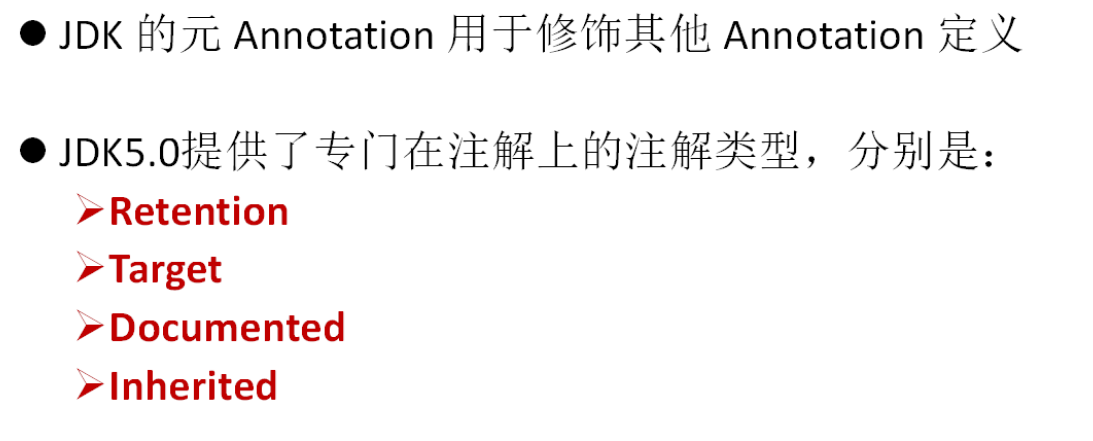| 8、枚举及注解 | |
| 8.1 如何自定义枚举类 | 1课时 |
| 8.2 如何使用关键字enum定义枚举类 | 1课时 |
| 8.3 枚举类的主要方法 | 1课时 |
| 8.4 实现接口的枚举类 | 1课时 |
jdk5.0之前案例
/**
* 1.枚举类:一个类中的对象是有限的、可数多个的。
*
* >如果枚举类的对象只有一个,可以看做是单例模式的实现方式。
*
* 2.如何自定义枚举类 ----jdk5.0之前
*
* 3.如何使用enum定义枚举类 ---jdk5.0
* >常用的方法:values() / valueOf(String s)
* >如何实现接口,使得每一个枚举类的对象分别重写接口中的抽象方法
*
*
*/
public class SeasonTest1 {
public static void main(String[] args) {
Season autumn = Season.AUTUMN;
System.out.println(autumn);
Season spring = Season.SPRING;
System.out.println(spring.getSEASONNAME());
System.out.println(spring.getSEASONDESC());
}
}
//枚举类
class Season{
//1.给类的对象声明声明,要求属性声明为:private final
private final String SEASONNAME;//季节的名称
private final String SEASONDESC;//季节的描述
//2.私有化构造器,并给常量赋值
private Season(String seasonName,String seasonDesc){
this.SEASONNAME = seasonName;
this.SEASONDESC = seasonDesc;
}
//3.提供当前枚举类的对象。声明为:public static final
public static final Season SPRING = new Season("春天", "春暖花开");
public static final Season SUMMER = new Season("夏天", "夏日炎炎");
public static final Season AUTUMN = new Season("秋天", "秋高气爽");
public static final Season WINTER = new Season("冬天", "白雪皑皑");
public String getSEASONNAME() {
return SEASONNAME;
}
public String getSEASONDESC() {
return SEASONDESC;
}
@Override
public String toString() {
return "Season [SEASONNAME=" + SEASONNAME + ", SEASONDESC=" + SEASONDESC + "]";
}
}
jdk5.0之后案例
//如何使用enum关键字定义枚举类
public class SeasonTest2 {
public static void main(String[] args) {
//1.values():返回所有枚举类对象构成的数组
Season1[] seasons = Season1.values();
for(int i = 0;i < seasons.length;i++){
System.out.println(seasons[i]);
seasons[i].show();
}
System.out.println();
//2.valueOf(String name):根据给定的枚举类对象名获取对应的枚举类的对象
//如果传入的枚举类对象名不准确,报java.lang.IllegalArgumentException异常。
String name = "AUTUMN";//String name = "AUTUMN1";
Season1 season = Season1.valueOf(name);
System.out.println(season);
}
}
interface Info{
void show();
}
//使用enum定义枚举类
enum Season1 implements Info{
SPRING("春天", "春暖花开"){
public void show(){
System.out.println("春天在哪里?");
}
},
SUMMER("夏天", "夏日炎炎"){
public void show(){
System.out.println("宁静的夏天");
}
},
AUTUMN("秋天", "秋高气爽"){
public void show(){
System.out.println("秋天是用来分手的季节");
}
},
WINTER("冬天", "白雪皑皑"){
public void show(){
System.out.println("2002年的第一场雪");
}
};
private final String SEASONNAME;//季节的名称
private final String SEASONDESC;//季节的描述
private Season1(String seasonName,String seasonDesc){
this.SEASONNAME = seasonName;
this.SEASONDESC = seasonDesc;
}
public String getSEASONNAME() {
return SEASONNAME;
}
public String getSEASONDESC() {
return SEASONDESC;
}
@Override
public String toString() {
return "Season1 [SEASONNAME=" + SEASONNAME + ", SEASONDESC=" + SEASONDESC + "]";
}
// @Override
// public void show() {
// System.out.println("这是一个季节!");
// }
}
Enum枚举类


实现接口的枚举类
- 和普通 Java 类一样,枚举类可以实现一个或多个接口
- 若需要每个枚举值在调用实现的接口方法呈现出不同的行为方式, 则可以让每个枚举值分别来实现该方法
8-2 注解(Annotation)
二、注解Annotation
主要内容
- JDK内置的基本注解类型(3个)
- 自定义注解类型
- 元注解:对注解进行注解(4个)
- 利用反射获取注解信息(在反射部分涉及)
- Java 8 中关于注解的修改
注解 (Annotation) 概述

注解(Annotation)的使用案例
/**
* 注解(Annotation)的使用
* 1.注解的理解:Annotation 其实就是代码里的特殊标记, 这些标记可以在编译, 类加载, 运行时被读取,
* 并执行相应的处理。通过使用 Annotation, 程序员可以在不改变原有逻辑的情况下, 在源文件中嵌入一些补充信息。
*
* 2.JDK 5.0 开始,提供了对元数据(Annotation)的支持
*
* 3.java中常见的三个注解:
*
* @Override: 限定重写父类方法, 该注解只能用于方法
* @Deprecated: 用于表示某个程序元素(类, 方法等)已过时
* @SuppressWarnings: 抑制编译器警告
*
* 4.如何自定义注解:
* 参照@SuppressWarnings定义即可
*
* 5.元注解:JDK 的元 Annotation 用于修饰其他 Annotation 定义
* @Retention:指明所修饰的注解的生命周期。 SOURCE,CLASS,RUNTIME
* @Target:指明所修饰的注解可以修饰的结构。
*
* @Documented:指明所修饰的注解是否可以被javadoc所解析。
* @Inherited:指明所修饰的注解是否具有继承性
*
* 6.如何在程序中获取注解信息:放在第15章的反射机制时讲。
* 前提:要求注解的生命周期必须声明为:RUNTIME.
*
* 7.java 8 中对注解的新规范:重复注解;类型注解
* 7.1重复注解@MyAnnotation:① @MyAnnotion使用元注解:@Repeatable
* ② @Repeatable的值为:另一个注解:@MyAnnotions
* ③ @MyAnnotions 定义时,内部的元素为:MyAnnotation[]
*
*/
public class AnnotationTest {
@SuppressWarnings({ "unused", "deprecation" })
public static void main(String[] args) {
Person p = new Student();
p.walk();
Date date = new Date(2007, 3, 23);
System.out.println(date);
String s = new String("abc");
// System.out.println(s);
}
}
//@MyAnnotations({@MyAnnotation("initial"),@MyAnnotation("initial")})
@MyAnnotation("initial")
@MyAnnotation("initial1")
class Person{
String name;
int age;
public Person(){}
public Person(String name){
this.name = name;
}
public void eat(){
System.out.println("吃饭");
}
public void walk(){
System.out.println("走路");
}
}
class Student extends @MyAnnotation Person{
@Deprecated
public Student(){
}
public Student(@MyAnnotation String name){ //Checker第三方的.jar包。 @NonNull
super(name);
}
@Override
public void eat() {
super.eat();
}
@Override
public void walk(){
System.out.println("学生走路");
}
}
import static java.lang.annotation.ElementType.CONSTRUCTOR;
import static java.lang.annotation.ElementType.FIELD;
import static java.lang.annotation.ElementType.LOCAL_VARIABLE;
import static java.lang.annotation.ElementType.METHOD;
import static java.lang.annotation.ElementType.PARAMETER;
import static java.lang.annotation.ElementType.TYPE;
import static java.lang.annotation.ElementType.TYPE_USE;
import java.lang.annotation.Repeatable;
import java.lang.annotation.Retention;
import java.lang.annotation.RetentionPolicy;
import java.lang.annotation.Target;
@Target({TYPE, FIELD, METHOD, PARAMETER, CONSTRUCTOR, LOCAL_VARIABLE,TYPE_USE})
@Retention(RetentionPolicy.CLASS)
@Repeatable(MyAnnotations.class)
public @interface MyAnnotation {
String value() default "hello";
}
import static java.lang.annotation.ElementType.CONSTRUCTOR;
import static java.lang.annotation.ElementType.FIELD;
import static java.lang.annotation.ElementType.LOCAL_VARIABLE;
import static java.lang.annotation.ElementType.METHOD;
import static java.lang.annotation.ElementType.PARAMETER;
import static java.lang.annotation.ElementType.TYPE;
import java.lang.annotation.Retention;
import java.lang.annotation.RetentionPolicy;
import java.lang.annotation.Target;
@Target({TYPE, FIELD, METHOD, PARAMETER, CONSTRUCTOR, LOCAL_VARIABLE})
@Retention(RetentionPolicy.CLASS)
public @interface MyAnnotations {
MyAnnotation[] value();
}
基本的 Annotation

自定义 Annotation

JDK 的元 Annotation





练 习
1.编写一个Person类,使用Override注解它的toString方法
2.自定义一个名为“MyTiger”的注解类型,它只可以使用在方法上,带一个String类型的value属性,然后在第1题中的Person类上正确使用。
提取 Annotation 信息

Java 8 中关于注解的修改
Java 8对注解处理提供了两点改进:可重复的注解及可用于类型的注解。此外,反射也得到了加强,在Java8中能够得到方法参数的名称。这会简化标注在方法参数上的注解。

@Target({TYPE, FIELD, METHOD, PARAMETER,PACKAGE, CONSTRUCTOR, LOCAL_VARIABLE,TYPE_PARAMETER})
@Retention(RetentionPolicy.RUNTIME)
@Repeatable(MyAnnotations.class)
public @interface MyAnnotation {
String[] value();
}
应用场景:
public Person(@MyAnnotation(value="notnull")String name){
this.name = name;
}